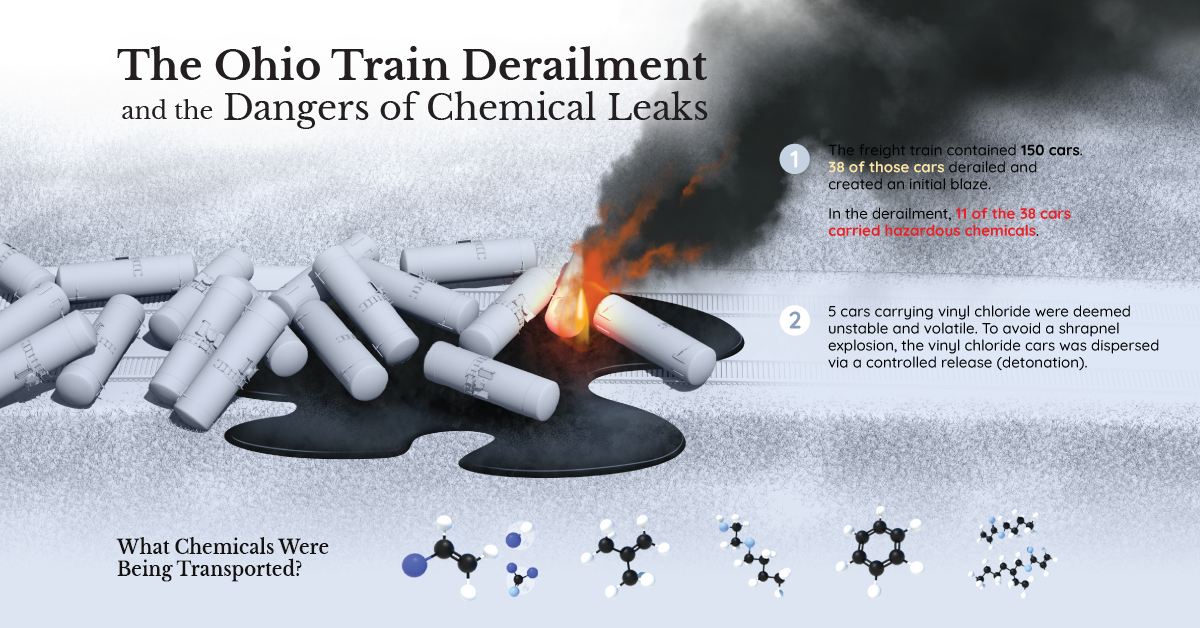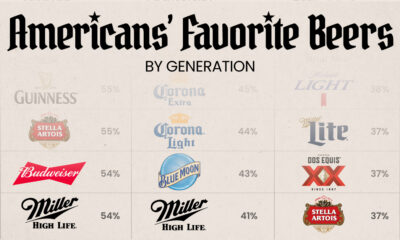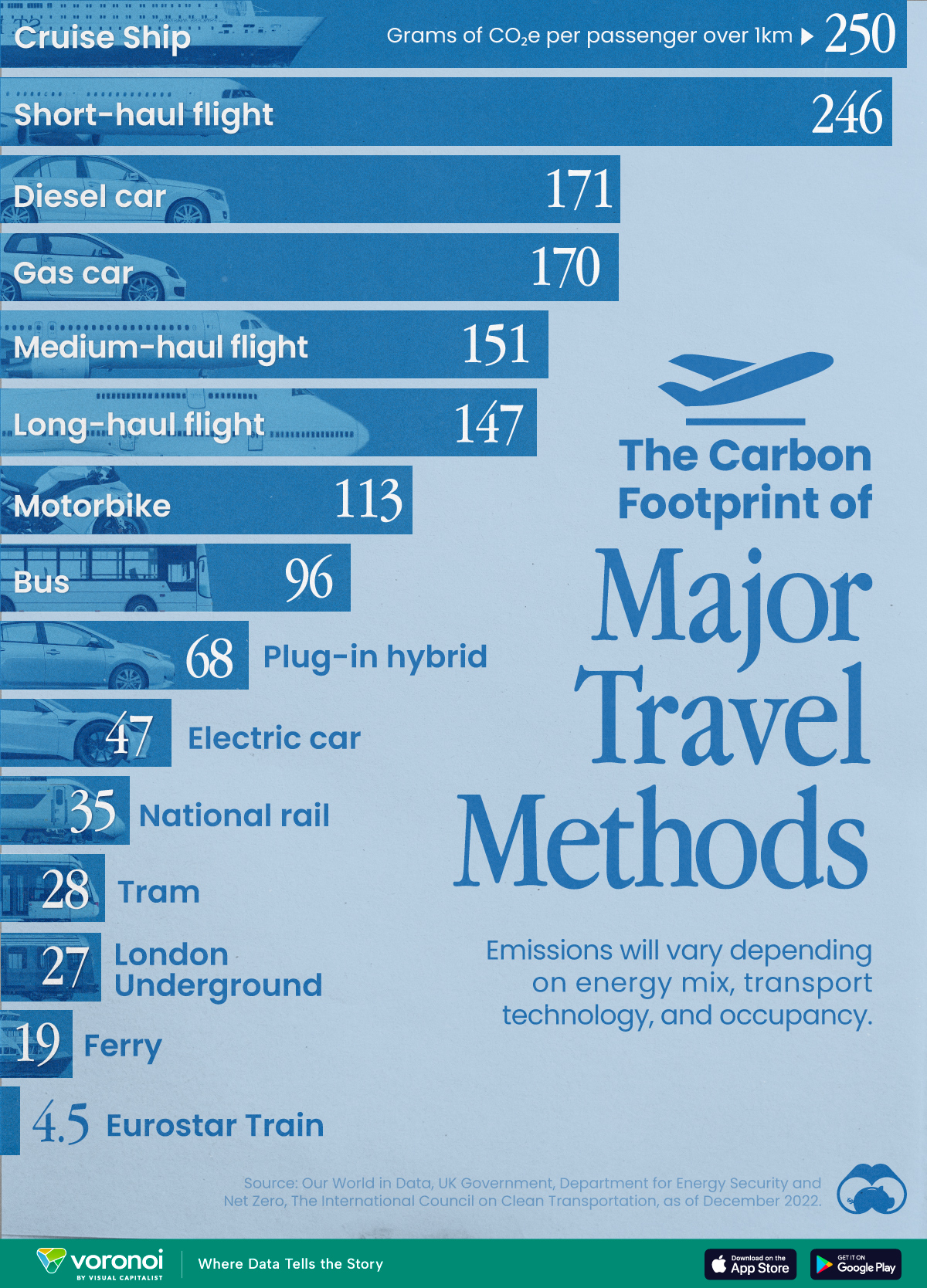Green
Explainer: What to Know About the Ohio Train Derailment
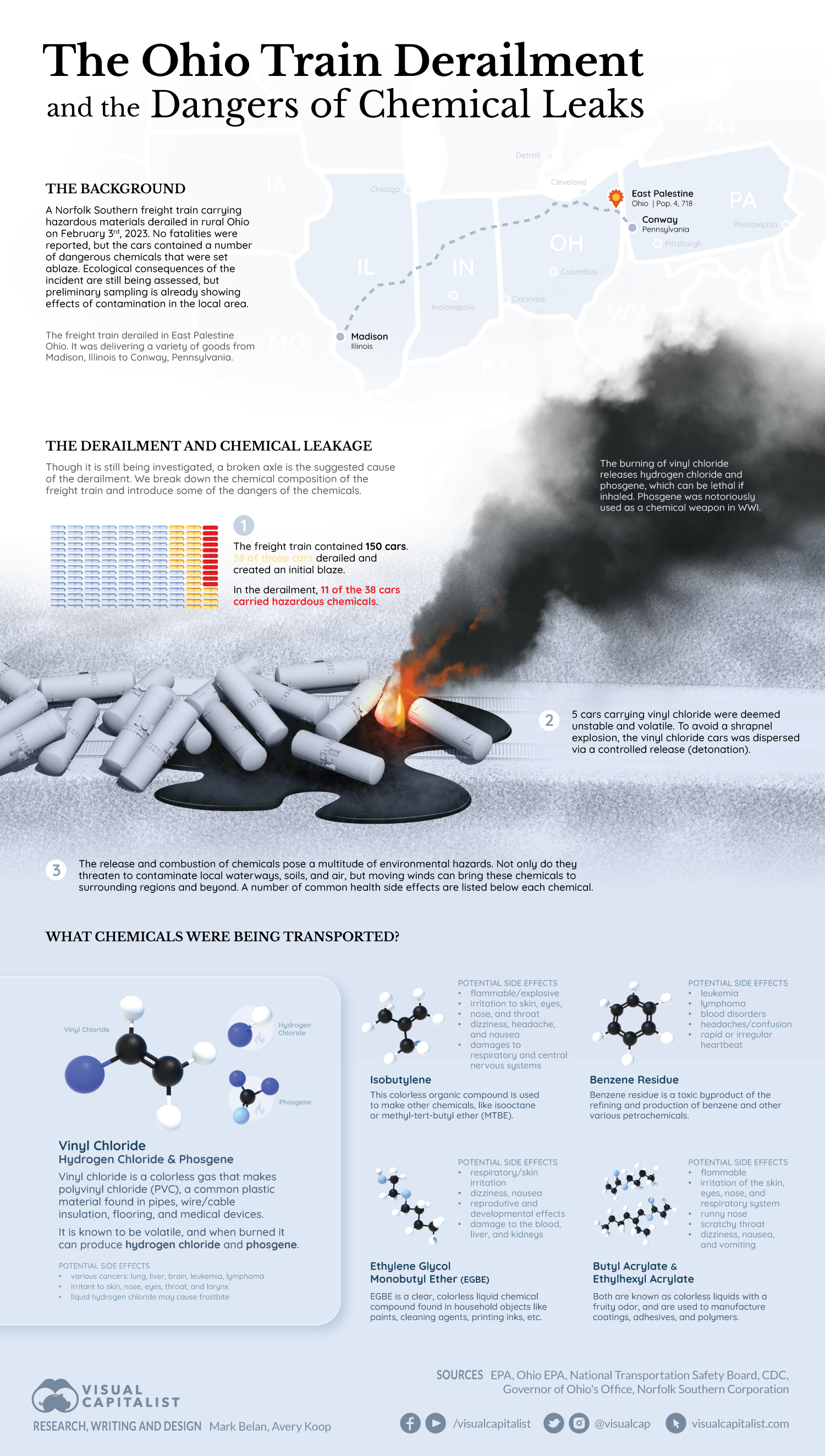
Explainer: What to Know About the Ohio Train Derailment
What started out as a seemingly commonplace train derailment near the border of Ohio and Pennsylvania in early February escalated into a serious threat to more than 4,000 people in the immediate area. Millions of people living in the vicinity of the derailment are also watching this situation closely as chemicals have made their way into the air and waterways.
Vinyl chloride, which was being transported on a number of the 150 train cars owned by Norfolk Southern, is a key cause for concern in the aftermath of the derailment. The chemical is a known carcinogen, and is dangerous when released into the environment.
In this piece, we’re providing a timeline, an explainer on the chemicals being carried by the train, the impact zone of the derailment and release of said chemicals, and the other basics you need to know.
What Was the Train Carrying?
The company that owns the train, Norfolk Southern, released a document detailing the train cars and what each carried, as well as whether or not it was damaged and/or derailed. Here are the highlights:
| Car Type | Load/MTY | Commodity | Haz Class | Status of Car |
|---|---|---|---|---|
| Hopper | Loaded | Polypropylene | Not in derailment pile | |
| Hopper | Loaded | Polypropylene | Not in derailment pile | |
| Hopper | Loaded | Polyethylene | lading destroyed by fire | |
| Hopper | Loaded | Polyethylene | lading destroyed by fire | |
| Tank Car | Empty | Residue lube oil | scrap pending C&P | |
| Tank Car | Loaded | Vinyl chloride, stabilized | 2.1 (FLAM. GAS) | car did not leak/cars vent product through the PRD and ignited/vent and burn performed |
| Tank Car | Loaded | Vinyl chloride, stabilized | 2.1 (FLAM. GAS) | car did not leak/cars vent product through the PRD and ignited/vent and burn performed |
| Tank Car | Loaded | Vinyl chloride, stabilized | 2.1 (FLAM. GAS) | car did not leak/cars vent product through the PRD and ignited/vent and burn performed |
| Tank Car | Loaded | Vinyl chloride, stabilized | 2.1 (FLAM. GAS) | vent product through the PRD and ignited/vent and burn |
| Tank Car | Loaded | Dipropylene glycol | fire impingement/no signs of tank breach | |
| Tank Car | Loaded | Propylene glycol | flame impingement, no tank breach found | |
| Tank Car | Loaded | Propylene glycol | tank breached/lost most of load | |
| Tank Car | Loaded | Diethylene glycol | had small leak from BOV, unknown amount of product in car | |
| Tank Car | Loaded | nos (ethylene glycol mono butyl ether) | COMB. LIQUID | unknown status |
| Hopper | Loaded | Semolina | in pile, destroyed by fire | |
| Tank Car | Loaded | nos (Ethylhexyl acrylate) | COMB. LIQUID | Car breached on head end/amount of product still in car pending |
| Hopper | Loaded | Polyvinyl | burned | |
| Hopper | Loaded | Polyvinyl | actively burning | |
| Tank Car | Loaded | Petroleum lube oil | double comp car/both breached/entire load lost | |
| Tank Car | Loaded | Petroleum lube oil | tank breached/lost most of load | |
| Tank Car | Loaded | Petroleum lube oil | flame impinged, may have had a small leak/will be determined when car is off loaded | |
| Tank Car | Loaded | Petroleum lube oil | flame impinged, small leak from top fittings, unknown amount left in tank | |
| Tank Car | Loaded | Polypropyl glycol | flame impinged, tank breached/ most of load lost | |
| Tank Car | Loaded | Propylene glycol | flame impinged, no signs of breach | |
| Tank Car | Loaded | Diethylene glycol | flame impinged, tank breached/ load lost | |
| Tank Car | Loaded | Diethylene glycol | flame impinged, lost unknown amount at this time from damaged BOV | |
| Tank Car | Loaded | Isobutylene | 2.1 (FLAM. GAS) | some flame impingement/no signs of breach |
| Tank Car | Loaded | Butyl acrylates, stabilized | 3 (FLAM. LIQUID) | Head breach/lost entire load (spill& fire) |
| Tank Car | Loaded | Petro oil, nec | flame impinged, small leak from VRV stopped, car still loaded | |
| Tank Car | Loaded | Additives, fuel | flame impinged, no sign of breach | |
| Hopper | Loaded | Polyvinyl | involved in fire | |
| Hopper | Loaded | Polyvinyl | involved in fire | |
| Tank Car | Loaded | Vinyl chloride, stabilized | 2.1 (FLAM. GAS) | car did not leak/cars vent product through the PRD and ignited/vent and burn performed |
| Box Car | Loaded | Balls, CTN, MEDCL | burning or has burned | |
| Box Car | Loaded | Sheet steel | burning or has burned | |
| Box Car | Loaded | Frozen vegetable | burning or has burned | |
| Tank Car | Empty | Benzene | 3 (FLAM. LIQUID) | damaged, fire impinged/ no breach |
| Tank Car | Empty | Benzene | 3 (FLAM. LIQUID) | damaged, fire impinged/ no breach |
| Tank Car | Loaded | Paraffin wax | flame impingement/no signs of breach | |
| Hopper | Loaded | Powder flakes | burned, extinguished | |
| Hopper | Loaded | Powder flakes | in line, upright, impinged | |
| Hopper | Loaded | Hydraulic cement | ||
| Autorack | Loaded | Autos passender | ||
| Box car | Loaded | Malt liquors | ||
| Box car | Loaded | Malt liquors | ||
| Box car | Loaded | Malt liquors | ||
| Box car | Loaded | Malt liquors | ||
| Box car | Loaded | Malt liquors | ||
| Box car | Loaded | Malt liquors | ||
| Box car | Loaded | Malt liquors | ||
| Box car | Loaded | Malt liquors | ||
| Box car | Loaded | Malt liquors |
Aside from dangerous chemicals, the train was carrying things like sheet steel, semolina, cement, malt liquor, and paraffin wax.
The Threat of the Chemical Substances
- Vinyl chloride: a gas which is commonly used to make PVC plastics. It is extremely flammable and produces toxic fumes when burned. It is also carcinogenic and can cause a myriad of health issues.
- Butyl acrylate: a liquid used for making sealants, adhesives, and paints. It can cause skin, respiratory, and eye irritation.
- Benzene residue: benzene is a highly flammable liquid. It is used to make things like rubbers, plastics, and dyes. It evaporates extremely quickly into the air and if exposed at high levels, it can cause dizziness, unconsciousness, tremors, irregular heartbeat, among other symptoms.
- Ethylhexyl acrylate: a liquid used to produce plastics and paint. It can cause respiratory and skin irritation. It can also produce a hazardous vapor under appropriate heat.
- Ethylene glycol monobutyl: a liquid that is primarily used as a solvent for inks and paints, as well as dry cleaning solutions. It is acutely toxic and can inflict serious or permanent injury. Vapors from the liquid can irritate the nose and eyes, and, if ingested, can cause vomiting and headaches.
- Combustible liquids
According to the CDC, many of these substances are frequently transported across the U.S.; benzene, for example, ranks in the top 20 chemicals by production volume in the country.
The Timeline
Friday, February 3rd: The train, which was heading from Madison, Illinois to Conway, Pennsylvania, was carrying various products from frozen vegetables to industrial chemicals. Near East Palestine, Ohio, just before the Pennsylvania border, 38 of the train’s 150 train cars derailed and subsequent fires caused damages to another 12. Additionally, 11 of the derailed train cars carried hazardous material, the most dangerous being vinyl chloride.
The derailment caused a large fire and ominous plumes of smoke over East Palestine, but there were no fatalities or injuries. According to the National Transportation Safety Board (NTSB), the cause of the derailment is still under investigation.
Saturday, February 4th: Environmental Protection Agency (EPA) crews began running air pollution and water runoff tests. They detected contaminated water in two streams, Sulphur Run and Leslie Run.
Sunday, February 5th: The EPA and Norfolk Southern’s contractors continued testing, and recovery efforts were underway at the contaminated water sites.
Monday, February 6th: Responders conducted a controlled burn of toxic materials to destroy the remaining vinyl chloride, which posed a threat of explosion and subsequent toxic fumes and shrapnel. Because of this the standing evacuation order was extended to include a larger area. From the Ohio governor’s announcement:
“The controlled release process involves the burning of the rail cars’ chemicals, which will release fumes into the air that can be deadly if inhaled. Based on current weather patterns and the expected flow of the smoke and fumes, anyone who remains in the red affected area is facing grave danger of death.” – Mike DeWine
Wednesday, February 8th: Just days later, the governor announced that it was safe for residents to return home as air quality tests were coming back clean.
In the last week: Reports have been coming in of people feeling symptoms related to the release of toxic chemicals. Additionally, the Ohio Department of Natural Resources, reported that 3,500 fish were found dead in Ohio waterways as a direct result of the spill from the train derailment.
The EPA, however, has screened the air quality inside more than 400 homes, finding levels to be safe. A statement from the regional director of the EPA said that: “Since the fire went out on February 8, EPA air monitoring has not detected any levels of health concern in the community that are attributed to the train derailment.”
On Wednesday, the 15th, Norfolk Southern representatives pulled out of a meeting with town officials, causing outrage among residents. The following day, EPA administrator, Michael Regan, visited East Palestine to quell the anger and fears, but residents are still unhappy and skeptical of the testing.
The largest remaining issue is that water quality connected to the Ohio River, which is still being monitored. The governor has recommended only drinking bottled water.
The Overall Impacts
The town of East Palestine is home to just over 4,000 people and the crash happened dangerously close to the city of Pittsburgh, PA. Contamination in the water supply have led to the deaths of thousands of fish and people are now complaining of reactions to the chemical leakage.
Norfolk Southern has set up an Assistance Center and donated over $1 million to help people cover costs of evacuation, as well as conducting extensive testing of air and water quality. The governor is now calling for tighter regulations on rail companies and a number of lawsuits have been filed against Norfolk Southern.
Green
The Carbon Footprint of Major Travel Methods
Going on a cruise ship and flying domestically are the most carbon-intensive travel methods.
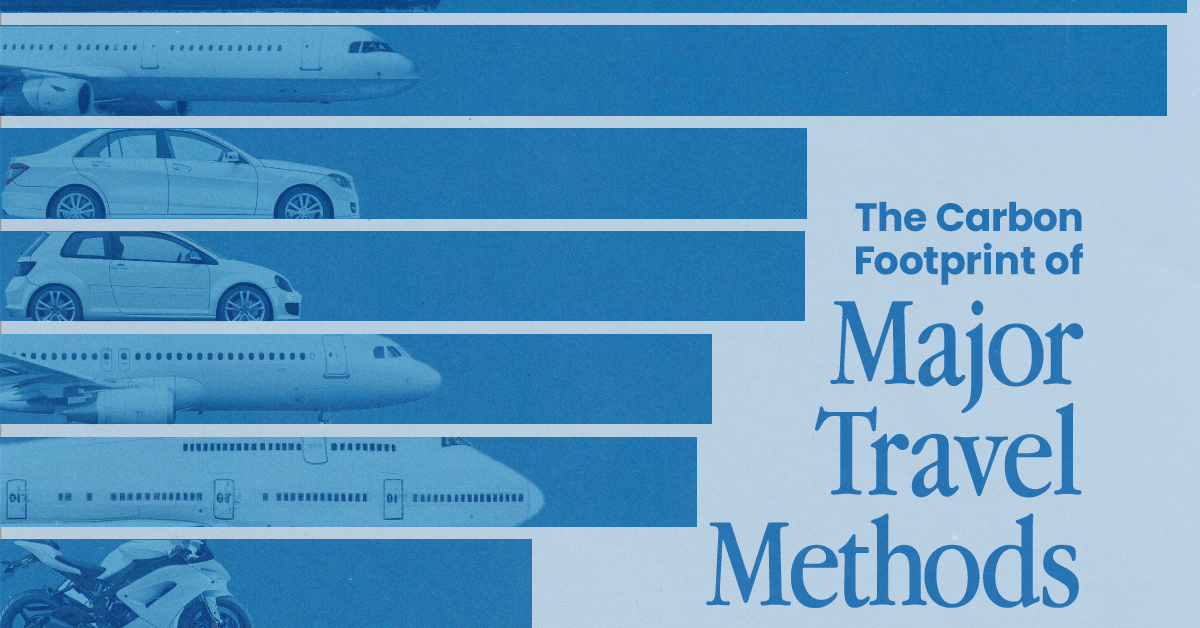
The Carbon Footprint of Major Travel Methods
This was originally posted on our Voronoi app. Download the app for free on iOS or Android and discover incredible data-driven charts from a variety of trusted sources.
Did you know that transport accounts for nearly one-quarter of global energy-related carbon dioxide (CO₂) emissions?
This graphic illustrates the carbon footprints of major travel methods measured in grams of carbon dioxide equivalent (CO₂e) emitted per person to travel one kilometer. This includes both CO₂ and other greenhouse gases.
Data is sourced from Our World in Data, the UK Government’s Department for Energy Security and Net Zero, and The International Council on Clean Transportation, as of December 2022.
These figures should be interpreted as approximations, rather than exact numbers. There are many variables at play that determine the actual carbon footprint in any individual case, including vehicle type or model, occupancy, energy mix, and even weather.
Cruise Ships are the Most Carbon-Intensive Travel Method
According to these estimates, taking a cruise ship, flying domestically, and driving alone are some of the most carbon-intensive travel methods.
Cruise ships typically use heavy fuel oil, which is high in carbon content. The average cruise ship weighs between 70,000 to 180,000 metric tons, meaning they require large engines to get moving.
These massive vessels must also generate power for onboard amenities such as lighting, air conditioning, and entertainment systems.
Short-haul flights are also considered carbon-intensive due to the significant amount of fuel consumed during initial takeoff and climbing altitude, relative to a lower amount of cruising.
| Transportation method | CO₂ equivalent emissions per passenger km |
|---|---|
| Cruise Ship | 250 |
| Short-haul flight (i.e. within a U.S. state or European country) | 246 |
| Diesel car | 171 |
| Gas car | 170 |
| Medium-haul flight (i.e. international travel within Europe, or between U.S. states) | 151 |
| Long-haul flight (over 3,700 km, about the distance from LA to NY) | 147 |
| Motorbike | 113 |
| Bus (average) | 96 |
| Plug-in hybrid | 68 |
| Electric car | 47 |
| National rail | 35 |
| Tram | 28 |
| London Underground | 27 |
| Ferry (foot passenger) | 19 |
| Eurostar (International rail) | 4.5 |
Are EVs Greener?
Many experts agree that EVs produce a lower carbon footprint over time versus traditional internal combustion engine (ICE) vehicles.
However, the batteries in electric vehicles charge on the power that comes straight off the electrical grid—which in many places may be powered by fossil fuels. For that reason, the carbon footprint of an EV will depend largely on the blend of electricity sources used for charging.
There are also questions about how energy-intensive it is to build EVs compared to a comparable ICE vehicle.
-

 Debt1 week ago
Debt1 week agoHow Debt-to-GDP Ratios Have Changed Since 2000
-

 Markets2 weeks ago
Markets2 weeks agoRanked: The World’s Top Flight Routes, by Revenue
-

 Demographics2 weeks ago
Demographics2 weeks agoPopulation Projections: The World’s 6 Largest Countries in 2075
-

 Markets2 weeks ago
Markets2 weeks agoThe Top 10 States by Real GDP Growth in 2023
-

 Demographics2 weeks ago
Demographics2 weeks agoThe Smallest Gender Wage Gaps in OECD Countries
-

 Economy2 weeks ago
Economy2 weeks agoWhere U.S. Inflation Hit the Hardest in March 2024
-

 Green2 weeks ago
Green2 weeks agoTop Countries By Forest Growth Since 2001
-

 United States2 weeks ago
United States2 weeks agoRanked: The Largest U.S. Corporations by Number of Employees

